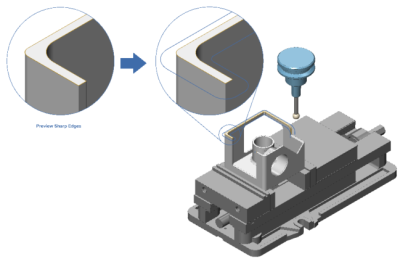
ModuleWorks announces the 2022.12 release of its digital manufacturing software components with new and enhanced features across the company’s entire CAD/CAM/CNC portfolio, including a new deburring preview, new cycles for rotary and turn milling, multi-regions for fused deposition modeling, and simulation and post processing for U-Axis turning operations.
Deburring: preview of sharp edges
For multi-axis subtractive machining, there is a new option to preview the automatically detected deburr edges before calculating the toolpath. Users can also include/exclude drive curves in/from the toolpath calculation to speed up programming.
Rotary machining and turn milling
The rotary machining component now offers a floor finishing cycle to complete the ModuleWorks basic finishing portfolio of wall and floor finishing.
In addition, users can now use the cusp height to adjust the stepover on rotary and turn milling operations. It works for all supported tools and incorporates the axis offset to eliminate complex manual calculations.
Machine and cutting simulation
The ModuleWorks Machine Simulation now supports U-axis turning where the part is static and the turning tool is mounted on the spindle and rotates around the workpiece. The Machine Simulation now also includes flexible machine components such as cables or elastic bellows that are used as machine covers. These components are attached to a fixed point and connect to a movable component.
For the Cutting Simulation, enhanced triangulation algorithms accelerate the generation of the simulation model. This also speeds up mesh export which significantly enhances the performance of stock management where the stock is exported after each operation.
Multi-regions for Fused Deposition Modeling
With this new feature for fused deposition modeling, users can divide a workpiece into separate regions and apply different settings to the layers, walls and infills in each region. This adds manufacturing versatility and enables operators to enhance the quality of the final product, for example by applying different infill densities to different regions to compensate for forces/pressures.
Post processing for U-Axis turning systems
The ModuleWorks MultiXPost post processor now supports U-Axis turning systems, also known as facing head or facing slide kinematics. The input is a turning toolpath. Markers on the toolpath indicate when to engage the special translation axis. This creates an operation where the machine first travels above the workpiece and then, using the U-Axis instead of the other translation axis, cuts the desired shape in turning mode.
Contact Details
Related Glossary Terms
- gang cutting ( milling)
gang cutting ( milling)
Machining with several cutters mounted on a single arbor, generally for simultaneous cutting.
- milling
milling
Machining operation in which metal or other material is removed by applying power to a rotating cutter. In vertical milling, the cutting tool is mounted vertically on the spindle. In horizontal milling, the cutting tool is mounted horizontally, either directly on the spindle or on an arbor. Horizontal milling is further broken down into conventional milling, where the cutter rotates opposite the direction of feed, or “up” into the workpiece; and climb milling, where the cutter rotates in the direction of feed, or “down” into the workpiece. Milling operations include plane or surface milling, endmilling, facemilling, angle milling, form milling and profiling.
- toolpath( cutter path)
toolpath( cutter path)
2-D or 3-D path generated by program code or a CAM system and followed by tool when machining a part.
- turning
turning
Workpiece is held in a chuck, mounted on a face plate or secured between centers and rotated while a cutting tool, normally a single-point tool, is fed into it along its periphery or across its end or face. Takes the form of straight turning (cutting along the periphery of the workpiece); taper turning (creating a taper); step turning (turning different-size diameters on the same work); chamfering (beveling an edge or shoulder); facing (cutting on an end); turning threads (usually external but can be internal); roughing (high-volume metal removal); and finishing (final light cuts). Performed on lathes, turning centers, chucking machines, automatic screw machines and similar machines.

